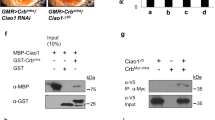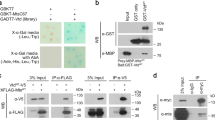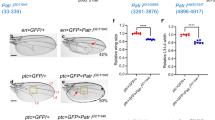Abstract
Crumbs (Crb) family proteins are crucial for cell polarity. Recent studies indicate that they are also involved in growth regulation and cancer. However, it is not well-understood how Crb participates in mitotic processes. Here, we report that Drosophila Crb is critically involved in nuclear division by interacting with Xeroderma pigmentosum D (XPD). A novel gene named galla-1 was identified from a genetic screen for crb modifiers. Galla-1 protein shows homology to MIP18, a subunit of the mitotic spindle-associated MMS19–XPD complex. Loss-of-function galla-1 mutants show abnormal chromosome segregation, defective centrosome positions and branched spindles during nuclear division in early embryos. Embryos with loss-of-function or overexpression of crb show similar mitotic defects and genetic interaction with galla-1. Both Galla-1 and Crb proteins show overlapping localization with spindle microtubules during nuclear division. Galla-1 physically interacts with the intracellular domain of Crb. Interestingly, Galla-1 shows little binding to the Drosophila homolog of XPD, but a related protein Galla-2 binds both Crb and Xpd. Loss-of-function galla-2 mutants show similar mitotic defects as galla-1 and strong genetic interaction with crb. Xpd can form a physical complex with Crb. In imaginal disc, Crb overexpression causes tissue overgrowth as well as DNA damages marked by H2Av phosphorylation. These phenotypes are suppressed by reduction of Xpd. Taken together, this study identifies a novel Crb–Galla–Xpd complex and its function for proper chromosome segregation during nuclear division, implicating a potential link between Crb and Xpd-related genome instability.
This is a preview of subscription content, access via your institution
Access options
Subscribe to this journal
Receive 50 print issues and online access
$259.00 per year
only $5.18 per issue
Buy this article
- Purchase on Springer Link
- Instant access to full article PDF
Prices may be subject to local taxes which are calculated during checkout








Similar content being viewed by others
References
Wolff TR, Ready DF . Pattern formation in the Drosophila retina. In: Bate M, Martinez-Arias A (eds). The Development of Drosophila Melanogaster. Cold Spring Harbor Laboratory Press: Plainview, NY, USA, 1993, pp 1277–1325.
Tepass U, Theres C, Knust E . Crumbs encodes an EGF-like protein expressed on apical membranes of Drosophila epithelial cells and required for organization of epithelia. Cell 1990; 61: 787–799.
Knust E, Dietrich U, Tepass U, Bremer KA, Weigel D, Vassin H et al. EGF homologous sequences encoded in the genome of Drosophila melanogaster, and their relation to neurogenic genes. EMBO J 1987; 6: 761–766.
Wodarz A, Hinz U, Engelbert M, Knust E . Expression of crumbs confers apical character on plasma membrane domains of ectodermal epithelia of drosophila. Cell 1995; 82: 67–76.
Izaddoost S, Nam S-C, Bhat MA, Bellen HJ, Choi K-W . Drosophila Crumbs is a positional cue in photoreceptor adherens junctions and rhabdomeres. Nature 2002; 416: 178–183.
Pellikka M, Tanentzapf G, Pinto M, Smith C, McGlade CJ, Ready DF et al. Crumbs, the Drosophila homologue of human CRB1/RP12, is essential for photoreceptor morphogenesis. Nature 2002; 416: 143–149.
den Hollander AI, Johnson K, de Kok YJM, Klebes A, Brunner HG, Knust E et al. CRB1 has a cytoplasmic domain that is functionally conserved between human and Drosophila. Hum Mol Genet 2001; 10: 2767–2773.
den Hollander AI, ten Brink JB, de Kok YJM, van Soest S, van den Born LI, van Driel MA et al. Mutations in a human homologue of Drosophila crumbs cause retinitis pigmentosa (RP12). Nat Genet 1999; 23: 217–221.
Chen C-L, Gajewski KM, Hamaratoglu F, Bossuyt W, Sansores-Garcia L, Tao C et al. The apical-basal cell polarity determinant Crumbs regulates Hippo signaling in Drosophila. Proc Natl Acad Sci USA 2010; 107: 15810–15815.
Ling C, Zheng Y, Yin F, Yu J, Huang J, Hong Y et al. The apical transmembrane protein Crumbs functions as a tumor suppressor that regulates Hippo signaling by binding to expanded. Proc Natl Acad Sci USA 2010; 107: 10532–10537.
Robinson BS, Huang J, Hong Y, Moberg KH . Crumbs regulates Salvador/Warts/Hippo Signaling in drosophila via the FERM-domain protein expanded. Curr Biol 2010; 20: 582–590.
Herranz H, Stamataki E, Feiguin F, Milan M . Self-refinement of Notch activity through the transmembrane protein Crumbs: modulation of gamma-Secretase activity. EMBO Rep 2006; 7: 297–302.
Klebes A, Knust E . A conserved motif in Crumbs is required for E-cadherin localisation and zonula adherens formation in Drosophila. Curr Biol 2000; 10: 76–85.
Bachmann A, Schneider M, Theilenberg E, Grawe F, Knust E . Drosophila Stardust is a partner of Crumbs in the control of epithelial cell polarity. Nature 2001; 414: 638–643.
Hong Y, Stronach B, Perrimon N, Jan LY, Jan YN . Drosophila Stardust interacts with Crumbs to control polarity of epithelia but not neuroblasts. Nature 2001; 414: 634–638.
Médina E, Williams J, Klipfell E, Zarnescu D, Thomas G, Le Bivic A . Crumbs interacts with moesin and βHeavy-spectrin in the apical membrane skeleton of Drosophila. J Cell Biol 2002; 158: 941–951.
Brust‐Mascher I, Scholey JM . Mitotic Spindle Dynamics in Drosophila. Int Rev Cytol 2007; 259: 139–172.
Tanentzapf G, Smith C, McGlade J, Tepass U . Apical, lateral, and basal polarization cues contribute to the development of the follicular epithelium during Drosophila oogenesis. J Cell Biol 2000; 151: 891–904.
Tepass U, Knust E . Phenotypic and developmental analysis of mutations at the crumbs locus, a gene required for the development of epithelia in Drosophila melanogaster. Roux’s Arch Dev Biol 1990; 199: 189–206.
Tepass U . The apical polarity protein network in Drosophila epithelial cells: regulation of polarity, junctions, morphogenesis, cell growth, and survival. Annu Rev Cell Dev Biol 2012; 28: 655–685.
Zurita M, Merino C . The transcriptional complexity of the TFIIH complex. Trends Genet 2003; 19: 578–584.
Ito S, Tan LJ, Andoh D, Narita T, Seki M, Hirano Y et al. MMXD, a TFIIH-independent XPD-MMS19 protein complex involved in chromosome segregation. Mol Cell 2010; 39: 632–640.
Gari K, León Ortiz AM, Borel V, Flynn H, Skehel JM, Boulton SJ . MMS19 links cytoplasmic iron-sulfur cluster assembly to DNA metabolism. Science 2012; 337: 243–245.
Stehling O, Vashisht AA, Mascarenhas J, Jonsson ZO, Sharma T, Netz DJA et al. MMS19 assembles iron-sulfur proteins required for DNA metabolism and genomic integrity. Science 2012; 337: 195–199.
Cameroni E, Stettler K, Suter B . On the traces of XPD: cell cycle matters–untangling the genotype-phenotype relationship of XPD mutations. Cell Div 2010; 5: 24.
Li X, Urwyler O, Suter B . Drosophila xpd regulates cdk7 localization, mitotic kinase activity, spindle dynamics, and chromosome segregation. PLoS Genet 2010; 6: e1000876.
Brand AH, Perrimon N . Targeted gene expression as a means of altering cell fates and generating dominant phenotypes. Development 1993; 118: 401–415.
Gao G, Bi X, Chen J, Srikanta D, Rong YS . Mre11-Rad50-Nbs complex is required to cap telomeres during Drosophila embryogenesis. Proc Natl Acad Sci USA 2009; 106: 10728–10733.
Su TT, Jaklevic B . DNA damage leads to a Cyclin A–dependent delay in metaphase-anaphase transition in the Drosophila gastrula. Curr Biol 2001; 11: 8–17.
Madigan JP, Chotkowski HL, Glaser RL . DNA double‐strand break‐induced phosphorylation of Drosophila histone variant H2Av helps prevent radiation‐induced apoptosis. Nucleic Acids Res 2002; 30: 3698–3705.
Perrimon N . Clonal analysis of dominant female-sterile, germline-dependent mutations in Drosophila melanogaster. Genetics 1984; 108: 927–939.
Rorth P . Gal4 in the Drosophila female germline. Mech Dev 1998; 78: 113–118.
Wodarz A, Grawe F, Knust E . CRUMBS is involved in the control of apical protein targeting during Drosophila epithelial development. Mech Dev 1993; 44: 175–187.
Huang J, Zhou W, Dong W, Watson AM, Hong Y . Directed, efficient, and versatile modifications of the Drosophila genome by genomic engineering. Proc Natl Acad Sci USA 2009; 106: 8284–8289.
Chen J, Larochelle S, Li X, Suter B . Xpd/Ercc2 regulates CAK activity and mitotic progression. Nature 2003; 424: 228–232.
Grzeschik NA, Parsons LM, Allott ML, Harvey KF, Richardson HE . Lgl, aPKC, and crumbs regulate the salvador/warts/hippo pathway through two distinct mechanisms. Curr Biol 2010; 20: 573–581.
Parsons LM, Grzeschik NA, Allott M, Richardson H . Lgl/aPKC and Crb regulate the Salvador/Warts/Hippo pathway. Fly 2010; 4: 288–293.
Hehnly H, Doxsey S . Rab11 endosomes contribute to mitotic spindle organization and orientation. Dev Cell 2014; 28: 497–507.
Capalbo L, D'Avino PP, Archambault V, Glover DM . Rab5 GTPase controls chromosome alignment through Lamin disassembly and relocation of the NuMA-like protein Mud to the poles during mitosis. Proc Natl Acad Sci USA 2011; 108: 17343–17348.
Li K, Kaufman TC . The homeotic target gene centrosomin encodes an essential centrosomal component. Cell 1996; 85: 585–596.
Frangioni JV, Neel BG . Solubilization and purification of enzymatically active Glutathione-S-Transferase (pGEX) fusion proteins. Anal Biochem 1993; 210: 179–187.
Thompson JD, Higgins DG, Gibson TJ . Clustal-W—improving the sensitivity of progressive multiple sequence alignment through sequence weighting, position-specific gap penalties and weight matrix choice. Nucleic Acids Res 1994; 22: 4673–4680.
Acknowledgements
We are grateful to Kyung-Ok Cho, Sang-Chul Nam and Walton Jones for critical comments on the manuscript. We thank Beat Suter and Tom Kaufmann for xpd mutant and anti-centrosomin antibody, respectively. We also thank Yang Hong for Crb::GFP and crb mutant alleles. We acknowledge the Bloomington Drosophila Stock Center, the National Institute of Genetics stock center and the Developmental Studies Hybridoma Bank for fly stocks and antibodies. This research was supported by grants from the World Class University Program (R31-2008-000-10071-0), the National President Fellowship (35B-2011-1-C00033) and the National Research Laboratory grant (NRF-2011-0028326) through the National Research Foundation of Korea funded by the Ministry of Education, Science & Technology.
Author information
Authors and Affiliations
Corresponding author
Ethics declarations
Competing interests
The authors declare no conflict of interest.
Additional information
Supplementary Information accompanies this paper on the Oncogene website
Supplementary information
Rights and permissions
About this article
Cite this article
Yeom, E., Hong, ST. & Choi, KW. Crumbs interacts with Xpd for nuclear division control in Drosophila. Oncogene 34, 2777–2789 (2015). https://doi.org/10.1038/onc.2014.202
Received:
Revised:
Accepted:
Published:
Issue Date:
DOI: https://doi.org/10.1038/onc.2014.202
This article is cited by
-
Modulation of Hippo signaling by Mnat9 N-acetyltransferase for normal growth and tumorigenesis in Drosophila
Cell Death & Disease (2022)
-
Ciao1 interacts with Crumbs and Xpd to regulate organ growth in Drosophila
Cell Death & Disease (2020)
-
Protein phosphatase 2A interacts with Verthandi/Rad21 to regulate mitosis and organ development in Drosophila
Scientific Reports (2019)



